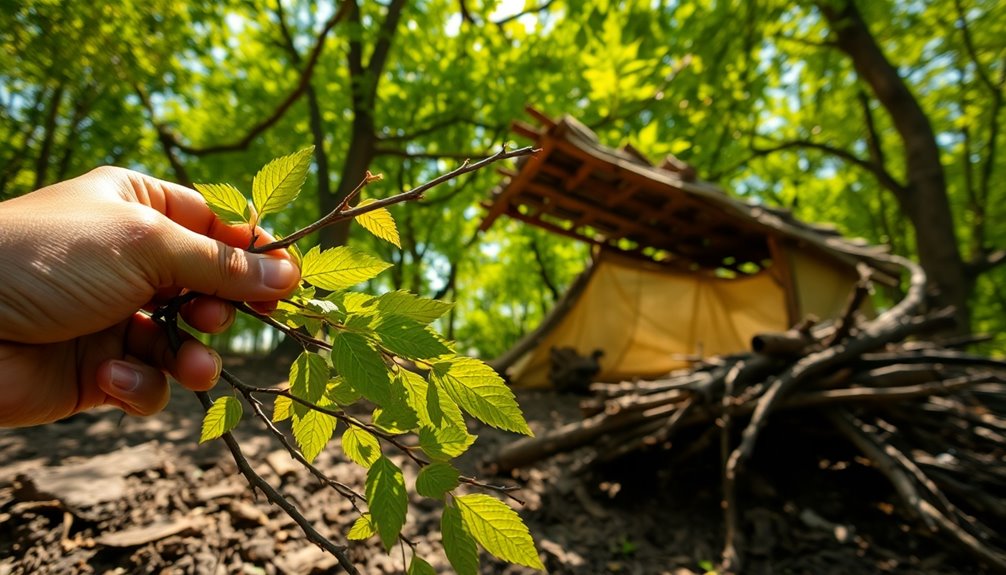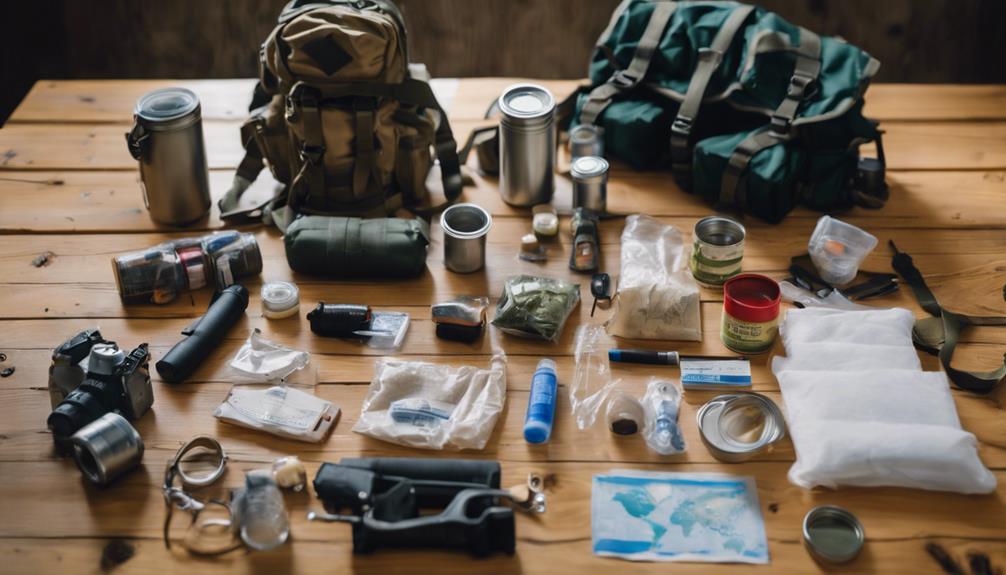Building a shelter in the wild is essential for your safety and comfort. First, choose a safe location, avoiding dead trees and low areas. Use sturdy materials like long branches for the frame and leaves for insulation. Construct simple structures like lean-tos or A-frames for better weather protection. Remember to secure everything well and position openings wisely to maintain stability. Clear away debris for comfort and safety. Always assess the local climate and potential hazards before starting. This foundational knowledge can greatly improve your outdoor experience, and there's so much more you can learn to enhance your wilderness skills.
Key Takeaways
- Choose a shelter location away from dead trees and low-lying areas to reduce injury and flooding risks.
- Use sturdy materials for your shelter's framework and roofing to prevent structural failures.
- Clear the ground of debris to enhance comfort and safety inside the shelter.
- Securely anchor the shelter and position openings wisely to maintain stability and integrity.
- Gather appropriate insulation materials, such as leaves and pine boughs, for warmth and comfort.
Types of Wilderness Shelters

When you're out in the wild, knowing the types of wilderness shelters can make all the difference in your survival. Natural shelters like rock shelters, found at the base of cliffs or bluffs, can provide excellent protection from the elements. You might also find natural hollows or tree hollows that offer a cozy refuge. Large fallen trees and rock overhangs can serve as effective shields against wind and rain.
If you prefer constructing your shelter, simple options like lean-tos are easy to make with branches and leaves. Pup tents are great for quick setups, while wedge tarp shelters are perfect for windy conditions. For added insulation, consider building leaf huts or bough beds for a comfortable sleeping area. Survival shelters are essential as they provide protection from the elements, enhancing your chances of staying safe outdoors.
For more advanced needs, A-frame shelters and debris shelters offer better weather protection. If you're in colder climates, specialized shelters like igloos and snow caves provide warmth and insulation. In desert environments, structures like ramadas or double-roofed tarp shelters help you stay cool. Each type of shelter has its unique advantages, so choose wisely based on your surroundings and needs.
Steps to Building a Shelter

Building a shelter in the wilderness requires careful planning and execution. First, you need to choose a safe location. Look for a spot that's clear of hazards like large trees or insect nests, and avoid low-lying areas to reduce the risk of flooding. High ground is ideal for visibility and drainage, and it's important to monitor for signs of local flora and fauna to ensure the safety of your chosen site.
Next, prepare the framework. Identify a sturdy ridgepole that's at least 8 feet long. You can use a tree stump, boulder, or a forked tree for support. For a lean-to, lean a long branch against a tree or rock, while an A-frame requires two sturdy branches to create the 'A' shape.
Finally, it's time to add ribbing and lattice. Use shorter branches at a 45-degree angle along both sides of the ridgepole, leaving space for a doorway. Create a lattice with smaller branches to hold debris in place, ensuring it's robust enough to support the weight.
Shelter Building Safety Tips

Safety is paramount in shelter building, as it directly impacts your well-being in the wild. To guarantee you're protected from various hazards, consider the following tips when selecting your shelter location and constructing it.
| Tip | Action | Reason |
|---|---|---|
| Location Selection | Avoid areas with dead trees | They may fall and cause injury |
| Hazard Mitigation | Steer clear of low-lying areas | They're prone to flooding |
| Structural Safety | Use strong materials for roofing | To prevent collapses |
Always pick a site with a natural windbreak and guarantee the ground is cleared of debris for comfort. Awareness of hazards is crucial, as it helps you identify potential risks in your environment. Be cautious of potential landslide risks, and don't forget to check for electrical hazards nearby. When constructing, securely anchor your shelter and enhance its structural integrity by positioning windows and doors wisely.
Choosing the Right Materials

Selecting the right materials is a fundamental step in constructing a reliable shelter in the wild. You'll want to gather resources that provide strength, insulation, and protection from the elements. Focus on using natural materials around you, making sure they're suitable for your shelter's design.
Here are three essential materials to take into account:
- Branches and Y-shaped Trees: Use uniform branches about three feet long for the walls and structure. Y-shaped trees can serve as the backbone of your shelter, providing stability.
- Leaves and Pine Boughs: These are great for insulation and lining the interior of your shelter. Healthy leaves will keep warmth in, while pine boughs add extra protection.
- Bark Slabs: Collect bark from dead trees like poplars or cottonwoods to create a waterproof layer. This will help keep your shelter dry during rain.
Additionally, make sure to consider the location for safety when selecting your materials, as it can significantly affect your shelter's effectiveness against the elements. Remember to layer your materials effectively and pack insulation at the base for warmth. Choosing the right materials not only guarantees your shelter's durability but also enhances your overall comfort and safety in the wild.
Preparing for Emergency Situations

Preparedness is vital when facing emergency situations in the wild, as it directly impacts your ability to survive and recover. Start by evaluating the geographical and climate conditions of your area. Identify potential hazards like flooding or landslides, and consider how the climate affects your shelter design. You'll need to guarantee your structure can withstand stresses, such as heavy snow or strong winds. Additionally, consider conducting an energy efficiency evaluation to optimize resource usage in your shelter.
Next, make certain your shelter design is culturally and socially appropriate. Involve the affected population in the planning process to meet their specific needs and preferences. This not only fosters a sense of ownership but also helps displaced individuals regain their livelihoods. Providing individual family shelters is preferred for privacy, comfort, and emotional safety.
It’s essential to provide important services and resources. Ensure access to water, sanitation, and energy near your shelter. Distribute necessary materials quickly, including insulation, blankets, and cooking equipment. Also, establish a communication plan with local authorities and neighbors to receive important updates and assistance in the event of an emergency. Additionally, prepare your home for emergencies by securing loose items, creating an emergency kit, and having an evacuation plan in place. These steps will help ensure the safety and well-being of yourself and your loved ones during challenging times.
Lastly, implement safety and protection measures. Seal your living space to keep warmth in and cold out, using plastic sheeting and insulation materials. Create shaded areas for cooking during warmer weather and choose locations that minimize risks of further displacement. Being well-prepared enhances your chances of survival in emergency situations.
Frequently Asked Questions
What Tools Are Essential for Building a Wilderness Shelter?
When building a wilderness shelter, you'll need essential tools to guarantee success. Start with a fixed-blade knife for versatile cutting and a folding saw for precise woodwork. An axe or hatchet helps with larger logs. Don't forget paracord for securing structures, and a tarp for waterproofing. A strong ridgepole and ribbing sticks form the framework, while a mallet can drive stakes. These tools will make your shelter-building experience more efficient and effective.
How Long Does It Take to Build a Shelter?
You might think building a shelter takes forever, but it doesn't have to. Depending on your situation, a simple lean-to can be constructed in under 30 minutes, perfect for quick protection. If you have more time, complex structures like debris huts can take several hours. By choosing a location close to materials and having a clear plan, you'll speed up the process and guarantee you're safe sooner rather than later.
Can I Use a Tarp for Any Shelter Type?
Yes, you can use a tarp for various shelter types. It's versatile! You can create an A-frame, lean-to, tarp tent, or diamond fly shelter, depending on your needs. Just make sure you have sturdy trees or poles, rope or paracord, and stakes to secure it. Each configuration provides different levels of protection and space, so choose one that fits your situation best. Just remember to keep it taut for ideal stability!
What Should I Do if I Encounter Wildlife Near My Shelter?
If you encounter wildlife near your shelter, stay calm and don't make sudden movements. Make noise to alert the animal of your presence, and try to keep your distance. If it approaches, back away slowly while facing the animal. Avoid direct eye contact, and never feed it. Once the animal leaves, check your surroundings to verify it's safe before returning to your activities. Keep your shelter organized to minimize attracting wildlife.
How Can I Improve Ventilation Inside My Shelter?
You'd think improving ventilation is rocket science, but it's simpler than that! Start by opening windows and doors to let fresh air flow in. You can also strategically place vents or fans to boost airflow. If you're in a humid area, consider shaded spaces to keep things cool. Regularly air out your shelter by opening windows at different times of the day, and keep the surroundings clean to enhance air quality.
Conclusion
So, whether you're hunkered down in a snowstorm or fending off the wilds of a bear-infested jungle, remember that building a shelter isn't just a skill—it's your ticket to survival glory! With the right materials and a dash of creativity, you'll transform into a wilderness architect, crafting a fortress that even King Kong would envy. So grab your gear, channel your inner survivalist, and get ready to conquer the great outdoors like the legend you are!










